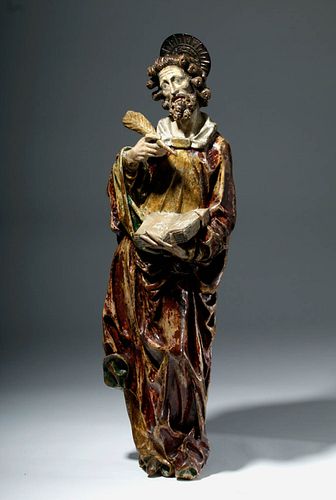18th C. Spanish Colonial Wood Santo - An Evangelist
Lot 126a
About Seller
Artemis Gallery
686 S Taylor Ave, Ste 106
Louisville, CO 80027
United States
Selling antiquities, ancient and ethnographic art online since 1993, Artemis Gallery specializes in Classical Antiquities (Egyptian, Greek, Roman, Near Eastern), Asian, Pre-Columbian, African / Tribal / Oceanographic art. Our extensive inventory includes pottery, stone, metal, wood, glass and textil...Read more
Categories
Estimate:
$4,500 - $6,750
Absentee vs Live bid
Two ways to bid:
- Leave a max absentee bid and the platform will bid on your behalf up to your maximum bid during the live auction.
- Bid live during the auction and your bids will be submitted real-time to the auctioneer.
Bid Increments
| Price | Bid Increment |
|---|---|
| $0 | $25 |
| $300 | $50 |
| $1,000 | $100 |
| $2,000 | $250 |
| $5,000 | $500 |
| $10,000 | $1,000 |
| $20,000 | $2,500 |
| $50,000 | $5,000 |
| $100,000 | $10,000 |
| $200,000 | $20,000 |
About Auction
By Artemis Gallery
Mar 4, 2021
Set Reminder
2021-03-04 10:00:00
2021-03-04 10:00:00
America/New_York
Bidsquare
Bidsquare : Ancient | Ethnographic Art Through The Ages
https://www.bidsquare.com/auctions/artemis-gallery/ancient-ethnographic-art-through-the-ages-6467
Ancient art from Egypt, Greece, Italy and the Near East, as well as Asian, Fossils, Pre-Columbian, Native American, African / Tribal / Oceanic, Fine art, and much more! All categories, all price ranges... all legally acquired and guaranteed to be as described or your money back. Artemis Gallery info@artemisgallery.com
Ancient art from Egypt, Greece, Italy and the Near East, as well as Asian, Fossils, Pre-Columbian, Native American, African / Tribal / Oceanic, Fine art, and much more! All categories, all price ranges... all legally acquired and guaranteed to be as described or your money back. Artemis Gallery info@artemisgallery.com
- Lot Description
Latin America, Mexico, ca. 18th century CE. A breathtaking santo depicting one of the Four Evangelists, either Matthew, Mark, Luke, or John, donning red, green, and gilded robes and a heavy gauge tin halo. He holds his Gospel in his right hand and a quill in his left, the attributes of a writer. This santo is impressively large in scale and finely carved; every cascading fold of his robes and curl of his coiffure is expertly delineated. Size: 10" W x 32" H (25.4 cm x 81.3 cm)
While we know this santo depicts one of the four Evangelists, identifying exactly which one is somewhat difficult because the artist did not present any of the symbols associated with each Apostle; the angel for Matthew, the lion for Mark, the ox for Luke, or the eagle for John. This said, we can probably rule out John, as he is typically shown without a beard being the younger brother of Saint James. The most educated guess would be that this santo represents Matthew, given that he is holding writing implements and is the author of the first Gospel. What the artist did wish to communicate was the Evangelist's pensive state, as his facial expression, with its thoughful eyes and wrinkled forehead, connotes that he is mid-thought or perhaps having an epiphany. Pausing for a moment, his entranced state suggests that the saint is experiencing a vision. Such imagery renditions would have endeared the Church to followers during the Spanish Colonial period.
Provenance: private Francis & Lilly Robicsek Collection, Charlotte, North Carolina, USA, acquired second half of the 20th century
All items legal to buy/sell under U.S. Statute covering cultural patrimony Code 2600, CHAPTER 14, and are guaranteed to be as described or your money back.
A Certificate of Authenticity will accompany all winning bids.
We ship worldwide and handle all shipping in-house for your convenience.
#119802Stable age cracks on the back and down torso continuing to the Gospel and wrist where it shows some separation and down the red robe just past the knee. Expected surface wear with craquelure and pigment losses as shown.Condition
- Shipping Info
-
All shipping is handled in-house for your convenience. Your invoice from Artemis Gallery will include shipping calculation instructions. If in doubt, please inquire BEFORE bidding for estimated shipping costs for individual items.
-
- Buyer's Premium



 EUR
EUR CAD
CAD AUD
AUD GBP
GBP MXN
MXN HKD
HKD CNY
CNY MYR
MYR SEK
SEK SGD
SGD CHF
CHF THB
THB




















